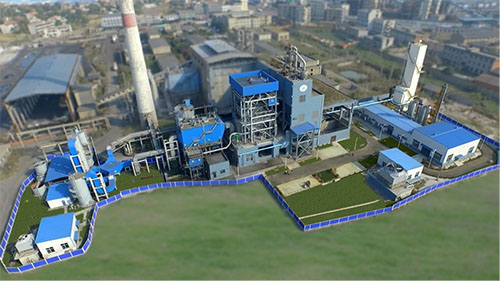Insights and Commentaries
Milestone Oxyfuel Plant Going into Operation in Hubei, China
16th May 2016
Topic(s): Carbon capture, use and storage (CCUS)
Oxyfuel combustion is a promising method of carbon capture and storage (CCS) due to its higher boiler efficiency and high CO2 concentration in exhaust gases. In this Insight Global CCS Institute Senior Adviser for Carbon Capture, Asia-Pacific, Dr Tony Zhang introduces the latest oxyfuel pilot plant — the Huazhong University of Science and Technology (HUST) Oxyfuel Plant in China.
Oxyfuel combustion processes use oxygen, rather than air, for combustion of fuel. This produces exhaust gas consisting almost exclusively of water vapour and CO2, which can be easily separated to produce a high purity CO2 stream. Three successful pilot plants using oxyfuel technology have already been built; The Vattenfall oxyfuel plant in Germany, which has successfully operated at 30 megawatts of thermal energy output (30MWthermal), Callide in Australia (30MWelectrical) and CUIDEN in Spain (20MWthermal). Now a new oxyfuel pilot plant is going into operation in China. In a project led by the Huazhong University of Science and Technology (HUST) the first large pilot for oxyfuel combustion in the East Asia region has successfully produced a highly concentrated CO2 stream at 3MW power output.
The Significance of CCS in China
According to China’s Energy Development Strategy Action Plan 2014–2020 issued by the State Council in 2014, green low carbon strategy is one of the key foci, and ambitious plans for expansion in renewable, nuclear and other forms of non-coal power generation have been established. However, by 2020, coal will still comprise around 62% of the total primary energy consumption in China.
Oxyfuel combustion has been considered one of the important low emission technologies due to its high boiler efficiency and readiness for CO2 liquefaction. Oxyfuel technology, as a carbon capture approach, has been tested in efforts around the world, and it has great potential to provide clean power with low emissions of SOx, NOx, particles, and CO2 due to its intrinsic nature — combustion with oxygen instead of air.
This technology may be used for retrofit of existing boilers or for new-build applications. It may be more attractive to power station operators than pre-combustion or post-combustion approaches due to its similarity to conventional boilers and the absence of extensive chemical engineering units. An oxyfuel combustion system may offer relatively lower system complexity than other capture systems.
Despite the efforts around the world for oxyfuel technology development, there remain key issues to be addressed for the deployment of this technology. This project aims to investigate the impacts of air leakage, oxy-air switch combustion, flue gas recycle and other system parameters. This project will provide valuable operational data for the development of large scale demonstration oxyfuel projects.
Description of the project
The HUST project received funding from China National Science and Technology Support Project Program. Huazhong University of Science and Technology is the project leader. It has partnered with Dongfang Boiler Co Ltd, Sichuan Air Separation Group, Guangdong Electric Power Research Institute, Shenhua Group and others.
The project started construction on 30 December 2012, and completed construction in June 2015. In September 2015, the project successfully produced high concentration CO2 (82.7%).
The plant includes an air separation unit (ASU), boiler, flue gas cleaning devices and flue gas recycling system. In addition to those standard components for an oxy-fuel combustion flowsheet, this plant includes the following unique features:
- High CO2 concentration — 82.7% CO2 produced in this process; whereas similar projects have CO2 concentrations between 67–72%
- Compatible design for air-combustion and oxy-combustion
- World’s first dry recycle for secondary flue gas extraction, which provides flexibility for using high sulfur coal
- A 3-column distiller for its Air Separation Unit (ASU) which yields better process performance for low pressure oxygen supply
- A boiler firing system equipped with three main swirling burners and two Over Fire Air System (OFA) burners, which makes the multi-burner performance study possible.
An artistic representation of the plant is shown in Figure 1.

Figure 1 Oxyfuel combustion plant in Yingcheng, Hubei Province, China(Courtesy of Huazhong University of Science and Technology)
Outlook of the project
This project further developed oxyfuel combustion technology and relevant equipment manufacture. In particular, the development of dry re-circulation of secondary flue gas provides better fuel flexibility in terms of sulfur content in coal fuel. This project will be key to the implementation of large scale carbon capture. This is an essential step in the oxyfuel technology development roadmap: 0.3 MW, 3MW, 35MW, 200MWe (electrical), 600MWe. The HUST team has carried out 0.3MW and 3MW oxyfuel combustion projects with the support of various government funding programs.
Significant experiences have been achieved by those smaller scale projects. Another benefit of the technology is that it removes most of the air pollutants, including SOx, NOx. The success of this project would no doubt create more novel knowledge and valuable experiences for the development of oxyfuel carbon capture technologies. The project partnership has also started work on a pre-feasibility study for a 200MWe oxy-combustion plant in North China, which would pave the way for future large scale oxyfuel project.